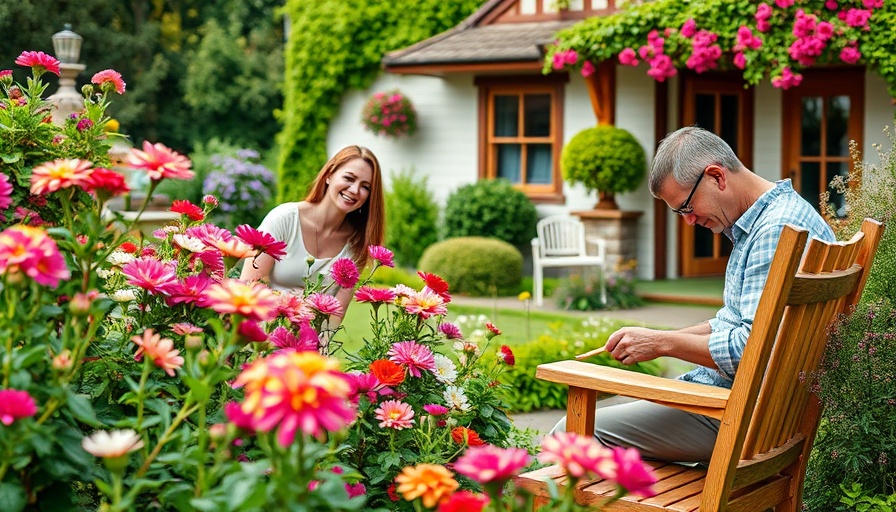
Transform Your Outdoor Space: Garden Design Ideas to Inspire
As the seasons change and the outdoors beckons, enhancing your garden can become a personal sanctuary right in your backyard. Inspired by the exploration of practical woodworking and sustainable practices, this article dives into innovative ways to make your outdoor space not only functional but also stunning. From DIY furniture projects to strategic planting, let’s revitalize your garden to create a delightful escape.
In 'Gorgeous Outdoor Furniture Ideas and Garden Design Goals,' the discussion dives into practical DIY projects and sustainable gardening concepts, exploring insights that sparked deeper analysis on our end.
DIY Outdoor Furniture: Crafting Personalized Comfort
Imagine returning home after a long day, ready to unwind in a charming outdoor chair you built yourself. The experience of crafting your own outdoor furniture can be incredibly rewarding. One popular project is to create a rustic deck chair from repurposed timber—easy enough for beginners yet fulfilling for seasoned DIYers. Using timber sourced from pallets, one can build a chair that not only serves the practical purpose of leisure seating but also brings a unique character to any garden space.
Beyond just the chair, consider additional pieces such as benches or tables using similar sustainable materials. These efforts not only help the environment but also add a personal touch to your garden, making it feel more like you.
Garden Design Goals: Bringing Nature Closer to Home
Achieving your ideal garden doesn't solely rely on furniture—it's about creating an environment where nature thrives, and you can comfortably escape. A carefully curated floral bed can showcase vibrant seasonal blooms, ideally inviting pollinators such as butterflies. Pair this with the right companionship plants to enhance visuals and biodiversity. Think about mixing perennials with annuals, ensuring color and vibrancy year-round.
Incorporate features such as raised garden beds for vegetable cultivation or herb gardens to not only beautify but also provide sustenance. This utilitarian approach helps in maintaining soil health and ensuring easy access, fostering a dinner plate right out of your own backyard.
Understanding the Basics: Lawn and Plant Care
As you embark on your garden journey, understanding the fundamentals of lawn care, pruning trees, and maintaining your flower beds can make a world of difference. Establishing a consistent watering schedule is key to keeping your plants flourishing; consider installing irrigation systems where possible. Staying engaged with your garden will promote better growth and health among the plants.
Furthermore, prioritizing composting not only recycles organic waste but enriches the soil, enriching your vegetable patch and flower beds alike. Together, these practices foster a rich ecosystem beneath the surface, guaranteeing that your garden remains lush and fruitful.
Intriguing Trends in Garden Design
The rise of sustainable gardening and vertical gardens is grabbing headlines as people seek to mix aesthetic beauty with eco-consciousness. Employing innovative techniques like xeriscaping or developing a low-water garden can showcase your commitment to sustainability while ensuring the beauty of your surroundings.
Consider adding features like rock gardens or water features to create focal points. These elements not only serve as appealing decorative aspects but also attract wildlife, enriching your garden’s ecosystem. Incorporate garden decor such as decorative stones or charming fairy lights to amplify ambience during the cool evening hours.
Get Hands-On: Actionable Gardening Tips
Diving into gardening doesn't require extensive experience. Start with simple hacks such as layering mulch to suppress weeds and maintain moisture. This isn’t merely advice—it's an actionable plan that anyone can follow. Establishing a flower border can delineate spaces within your garden while defining both functionality and beauty.
Whether you're new to gardening or looking to refine your skills, experimenting with container gardening enables flexibility while ensuring an appealing design. Small pots can be used for herbs, while larger containers can house vibrant flowering plants. All of these choices contribute to curb appeal while allowing for exquisite, personalized touches.
Creating a Wildlife-Friendly Garden
Lastly, integrating a wildlife garden encourages a biodiverse ecosystem. Choose plants that attract beneficial pests while providing food sources for local wildlife. Bird-friendly options like berry bushes or butterfly gardens encourage fascinating interactions with the natural world right outside your window.
Implementing these strategies not only enhances your garden’s beauty but ensures it becomes a thriving ecosystem. By making small changes, the impact can lead to transformative experiences both aesthetically and for the local wildlife.
 Add Row
Add Row  Add
Add 




Write A Comment